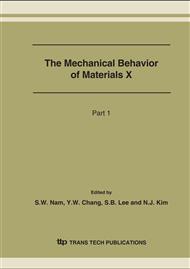p.445
p.449
p.453
p.457
p.461
p.465
p.469
p.473
p.477
Effects of Alloying Elements on Fracture Properties of Niobium Stabilized Austenitic Steels at Elevated Temperature
Abstract:
The present work is a further investigation into the effects of the carbon (C), nitrogen (N) and niobium (Nb) contents on then fracture properties of the Type 347 stainless steels at 316oC. 9 heats of systematically designed alloys were examined. Through SEM-EDS, TEM and XRD analyses, two kinds of precipitates, Nb(C,N), CrNbN were identified in the Type 347 steels with a high ratio of wt% N to wt% C, on the other hand only Nb(C,N)s were found in the Type 347 steels with a low ratio of wt% N to wt% C. The tearing moduli were decreased in the range of 52~60% as the carbon content increased from 0.03wt% to 0.05wt%. The tearing moduli were lowered by 52~59% in the alloys with a high nitrogen. It was deduced from the microstructure analysis results that the coarse Nb-rich precipitates control the fracture resistance of the Type 347 as they act as the potential sites for the nucleation of micro-voids.
Info:
Periodical:
Pages:
461-464
Citation:
Online since:
August 2007
Authors:
Keywords:
Price:
Сopyright:
© 2007 Trans Tech Publications Ltd. All Rights Reserved
Share:
Citation:


